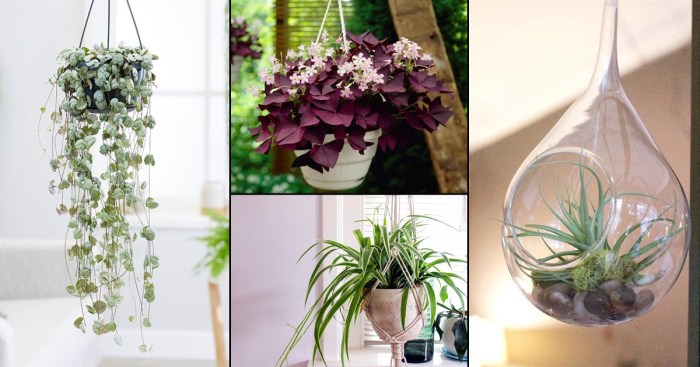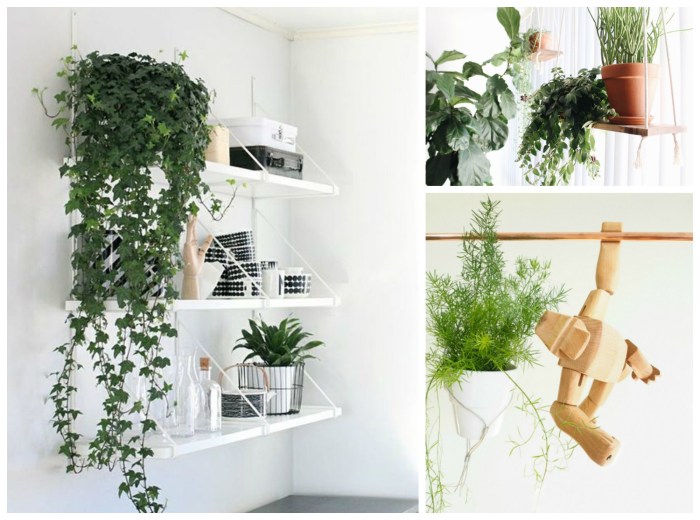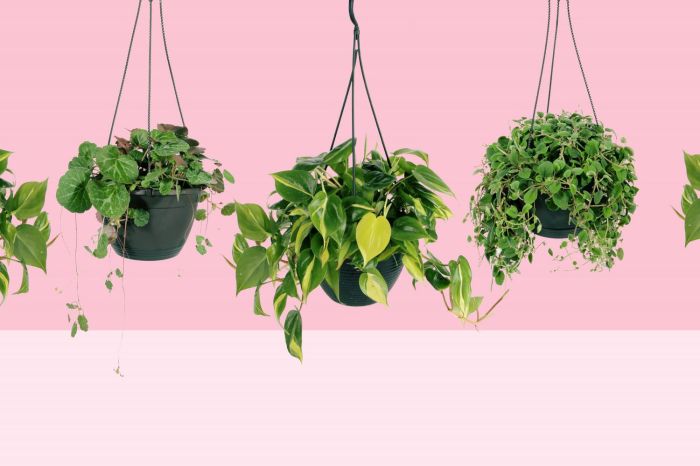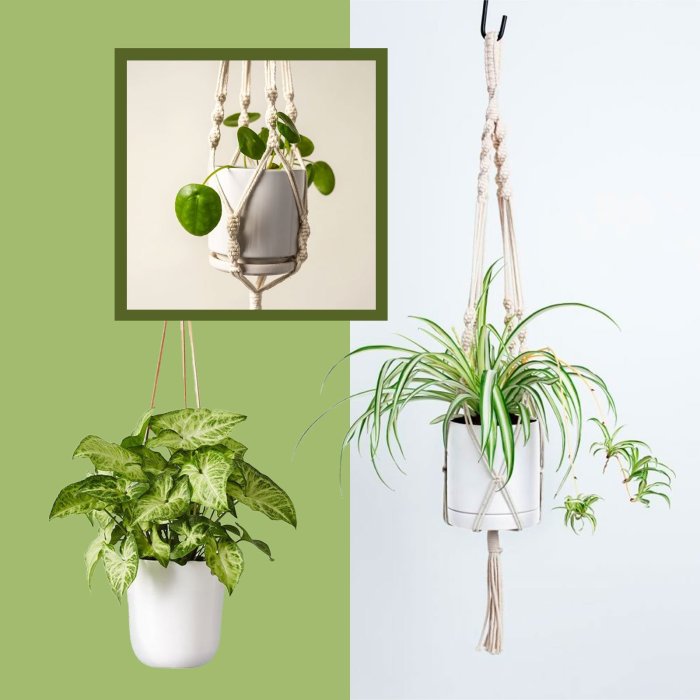5 different types of hanging house plants – Discover the beauty and benefits of incorporating hanging houseplants into your interior design. From cascading String of Pearls to air-purifying Spider Plants, these versatile greenery options offer a touch of elegance and freshness to any space.
Types of Hanging Houseplants

Hanging houseplants are a popular choice for interior design, as they add a touch of greenery and life to any room. They are also a great way to add some extra height and dimension to a space.
For indoor spaces, hanging house plants offer a unique way to add greenery and create a cozy atmosphere. Whether you prefer the trailing vines of a String of Pearls or the delicate foliage of a Spider Plant, there are five different types of hanging house plants to choose from.
Decorative Hanging Planters for Indoor Spaces: Enhance Your Home with Greenery provides a comprehensive guide to selecting and caring for these beautiful plants. With proper care, these hanging plants can bring a touch of nature and style to any room.
There are many different types of hanging houseplants to choose from, each with its own unique look and care requirements. Some of the most popular types of hanging houseplants include:
- Pothos
- Spider plants
- Ferns
- Trailing succulents
- Air plants
Benefits of Hanging Houseplants
Hanging houseplants offer a number of benefits, including:
- They can help to purify the air.
- They can help to reduce stress and anxiety.
- They can add a touch of color and life to any room.
- They can be a great way to add some extra height and dimension to a space.
String of Pearls (Senecio rowleyanus)

The String of Pearls is a unique and eye-catching succulent that is perfect for hanging baskets. Its long, trailing stems are adorned with plump, pea-sized leaves that resemble strings of pearls. This plant is relatively easy to care for, making it a great choice for both experienced and novice gardeners.
Care
String of Pearls prefers bright, indirect light. Water the plant thoroughly when the soil is dry to the touch. Allow the excess water to drain away completely. Fertilize the plant monthly during the growing season with a balanced liquid fertilizer.
Growth Pattern
String of Pearls has a trailing growth habit, which makes it ideal for hanging baskets or windowsills. The plant can grow up to 2 feet long. The leaves are arranged in a spiral pattern along the stems. The plant produces small, white flowers in the summer.
Spider Plant (Chlorophytum comosum): 5 Different Types Of Hanging House Plants

The Spider Plant is a popular hanging houseplant known for its long, arching leaves and trailing plantlets, or “spiderettes.” Its versatility and ease of care make it a great choice for both beginners and experienced plant enthusiasts.
Propagation
Spider Plants are easy to propagate through their plantlets. Simply remove the plantlets from the mother plant, ensuring that they have a few roots, and plant them in a new pot with well-draining soil. Keep the soil moist and provide bright, indirect light, and the plantlets will quickly establish themselves.
5 different types of hanging house plants include the string of pearls, spider plant, pothos, philodendron, and maidenhair fern. For more information on these and other hanging plants, visit Plants .
Air-Purifying Qualities
In addition to their aesthetic appeal, Spider Plants are also known for their air-purifying qualities. Studies have shown that they can remove harmful pollutants, such as formaldehyde and xylene, from the air, making them a beneficial addition to any home or office.
For those seeking to enhance their indoor ambiance with greenery, hanging house plants offer a captivating solution. From the cascading tendrils of the String of Pearls to the graceful arch of the Spider Plant, these five different types of hanging house plants bring a touch of nature’s beauty into any living space.
To explore more varieties and learn about their care requirements, visit Different Types of Indoor Hanging Plants: Beautify Your Home with Nature’ for comprehensive insights into the fascinating world of hanging house plants.
Burro’s Tail (Sedum morganianum)

Burro’s Tail, a succulent native to Mexico, captivates with its cascading stems adorned with plump, fleshy leaves. Its trailing habit makes it an ideal choice for hanging baskets or elevated planters.
Watering Requirements
Like other succulents, Burro’s Tail prefers infrequent watering. Allow the soil to dry out completely before watering again. Overwatering can lead to root rot, a fatal condition for succulents.
Sunlight Requirements
Burro’s Tail thrives in bright, indirect light. Avoid direct sunlight, as it can scorch the leaves. If the plant receives too little light, it may become leggy and lose its vibrant color.
Golden Pothos (Epipremnum aureum)

Golden Pothos is a popular houseplant known for its trailing vines and variegated leaves. It’s a low-maintenance plant that can tolerate a wide range of conditions, making it suitable for both beginners and experienced plant enthusiasts.Golden Pothos is native to the Solomon Islands and is part of the Araceae family.
It’s a vigorous grower and can quickly fill a hanging basket or trailing pot. The leaves are heart-shaped and come in various shades of green, yellow, and white.
Varieties of Golden Pothos
There are several varieties of Golden Pothos, each with unique leaf patterns and colors. The most common varieties include:
| Variety | Leaf Coloration |
|---|---|
| Neon | Bright yellow-green leaves with minimal variegation |
| Marble Queen | White and green marbled leaves |
| Golden | Deep green leaves with bright yellow variegation |
| Jessenia | Large, variegated leaves with cream, green, and yellow markings |
| Pearls and Jade | Small, round leaves with green and white variegation |
Ease of Care and Adaptability, 5 different types of hanging house plants
Golden Pothos is an easy-to-care-for plant that can thrive in various environments. It prefers bright indirect light but can tolerate low-light conditions. The plant should be watered when the soil is dry to the touch. Avoid overwatering, as this can lead to root rot.Golden
From the cascading elegance of pothos to the trailing tendrils of spider plants, there are countless hanging house plants to choose from. For those looking to elevate their indoor decor, Decorative Indoor Plant Hangers: A Guide to Adding Style and Greenery to Your Home offers a comprehensive guide to selecting and showcasing these botanical wonders.
With its tips on choosing the right hangers, arranging plants for maximum impact, and incorporating greenery into any room, this guide will help you create a stunning and serene indoor oasis with hanging house plants.
Pothos is also adaptable to different temperatures and humidity levels. It can tolerate temperatures ranging from 60 to 85 degrees Fahrenheit (15 to 29 degrees Celsius) and prefers moderate to high humidity. However, it can also survive in lower humidity environments.
Last Word

Whether you’re a seasoned plant enthusiast or just starting your indoor gardening journey, these five hanging houseplants are sure to add a vibrant and inviting touch to your home. Their unique appearances, ease of care, and air-purifying qualities make them perfect for creating a stylish and healthy living environment.
Question & Answer Hub
What are the benefits of using hanging houseplants in interior design?
Hanging houseplants add a touch of elegance and freshness to any space, creating a sense of depth and visual interest. They can also help purify the air, improve indoor air quality, and reduce stress levels.
Which hanging houseplant is easiest to care for?
Golden Pothos is known for its ease of care and adaptability. It can tolerate a wide range of light conditions and requires minimal watering, making it a great choice for beginners.
How often should I water my Burro’s Tail?
Burro’s Tail is a succulent and does not require frequent watering. Allow the soil to dry out completely between waterings, and then water thoroughly.